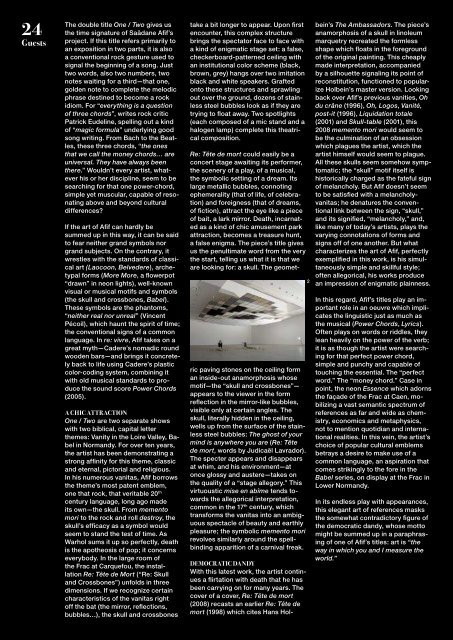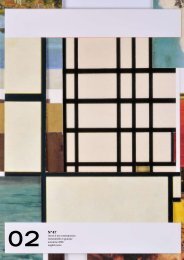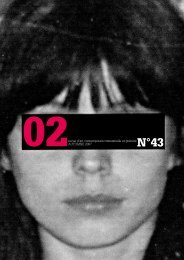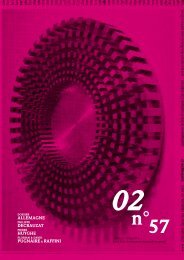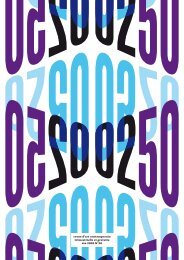N°46 / revue d'art contemporain trimestrielle et gratuite / été 2008 ...
N°46 / revue d'art contemporain trimestrielle et gratuite / été 2008 ...
N°46 / revue d'art contemporain trimestrielle et gratuite / été 2008 ...
You also want an ePaper? Increase the reach of your titles
YUMPU automatically turns print PDFs into web optimized ePapers that Google loves.
24<br />
Guests<br />
The double title One / Two gives us<br />
the time signature of Saâdane Afif’s<br />
project. If this title refers primarily to<br />
an exposition in two parts, it is also<br />
a conventional rock gesture used to<br />
signal the beginning of a song. Just<br />
two words, also two numbers, two<br />
notes waiting for a third—that one,<br />
golden note to compl<strong>et</strong>e the melodic<br />
phrase destined to become a rock<br />
idiom. For “everything is a question<br />
of three chords”, writes rock critic<br />
Patrick Eudeline, spelling out a kind<br />
of “magic formula” underlying good<br />
song writing. From Bach to the Beatles,<br />
these three chords, “the ones<br />
that we call the money chords… are<br />
universal. They have always been<br />
there.” Wouldn’t every artist, whatever<br />
his or her discipline, seem to be<br />
searching for that one power-chord,<br />
simple y<strong>et</strong> muscular, capable of resonating<br />
above and beyond cultural<br />
differences?<br />
If the art of Afif can hardly be<br />
summed up in this way, it can be said<br />
to fear neither grand symbols nor<br />
grand subjects. On the contrary, it<br />
wrestles with the standards of classical<br />
art (Laocoon, Belvedere), arch<strong>et</strong>ypal<br />
forms (More More, a flowerpot<br />
“drawn” in neon lights), well-known<br />
visual or musical motifs and symbols<br />
(the skull and crossbones, Babel).<br />
These symbols are the phantoms,<br />
“neither real nor unreal” (Vincent<br />
Pécoil), which haunt the spirit of time;<br />
the conventional signs of a common<br />
language. In re: vivre, Afif takes on a<br />
great myth—Cadere’s nomadic round<br />
wooden bars—and brings it concr<strong>et</strong>ely<br />
back to life using Cadere’s plastic<br />
color-coding system, combining it<br />
with old musical standards to produce<br />
the sound score Power Chords<br />
(2005).<br />
A chic AttrAction<br />
One / Two are two separate shows<br />
with two biblical, capital l<strong>et</strong>ter<br />
themes: Vanity in the Loire Valley, Babel<br />
in Normandy. For over ten years,<br />
the artist has been demonstrating a<br />
strong affinity for this theme, classic<br />
and <strong>et</strong>ernal, pictorial and religious.<br />
In his numerous vanitas, Afif borrows<br />
the theme’s most patent emblem,<br />
one that rock, that veritable 20 th<br />
century language, long ago made<br />
its own—the skull. From memento<br />
mori to the rock and roll destroy, the<br />
skull’s efficacy as a symbol would<br />
seem to stand the test of time. As<br />
Warhol sums it up so perfectly, death<br />
is the apotheosis of pop; it concerns<br />
everybody. In the large room of<br />
the Frac at Carquefou, the installation<br />
Re: Tête de Mort (“Re: Skull<br />
and Crossbones”) unfolds in three<br />
dimensions. If we recognize certain<br />
characteristics of the vanitas right<br />
off the bat (the mirror, reflections,<br />
bubbles…), the skull and crossbones<br />
take a bit longer to appear. upon first<br />
encounter, this complex structure<br />
brings the spectator face to face with<br />
a kind of enigmatic stage s<strong>et</strong>: a false,<br />
checkerboard-patterned ceiling with<br />
an institutional color scheme (black,<br />
brown, grey) hangs over two imitation<br />
black and white speakers. Grafted<br />
onto these structures and sprawling<br />
out over the ground, dozens of stainless<br />
steel bubbles look as if they are<br />
trying to float away. Two spotlights<br />
(each composed of a mic stand and a<br />
halogen lamp) compl<strong>et</strong>e this theatrical<br />
composition.<br />
Re: Tête de mort could easily be a<br />
concert stage awaiting its performer,<br />
the scenery of a play, of a musical,<br />
the symbolic s<strong>et</strong>ting of a dream. Its<br />
large m<strong>et</strong>allic bubbles, connoting<br />
ephemerality (that of life, of celebration)<br />
and foreigness (that of dreams,<br />
of fiction), attract the eye like a piece<br />
of bait, a lark mirror. Death, incarnated<br />
as a kind of chic amusement park<br />
attraction, becomes a treasure hunt,<br />
a false enigma. The piece’s title gives<br />
us the penultimate word from the very<br />
the start, telling us what it is that we<br />
are looking for: a skull. The geom<strong>et</strong>-<br />
ric paving stones on the ceiling form<br />
an inside-out anamorphosis whose<br />
motif—the “skull and crossbones”—<br />
appears to the viewer in the form<br />
reflection in the mirror-like bubbles,<br />
visible only at certain angles. The<br />
skull, literally hidden in the ceiling,<br />
wells up from the surface of the stainless<br />
steel bubbles: The ghost of your<br />
mind is anywhere you are (Re: Tête<br />
de mort, words by Judicaël Lavrador).<br />
The specter appears and disappears<br />
at whim, and his environment—at<br />
once glossy and austere—takes on<br />
the quality of a “stage allegory.” This<br />
virtuoustic mise en abîme tends towards<br />
the allegorical interpr<strong>et</strong>ation,<br />
common in the 17 th century, which<br />
transforms the vanitas into an ambiguous<br />
spectacle of beauty and earthly<br />
pleasure; the symbolic memento mori<br />
revolves similarly around the spellbinding<br />
apparition of a carnival freak.<br />
DemocrAtic DAnDY<br />
With this latest work, the artist continues<br />
a flirtation with death that he has<br />
been carrying on for many years. The<br />
cover of a cover, Re: Tête de mort<br />
(<strong>2008</strong>) recasts an earlier Re: Tête de<br />
mort (1998) which cites Hans Hol-<br />
2<br />
bein’s The Ambassadors. The piece’s<br />
anamorphosis of a skull in linoleum<br />
marqu<strong>et</strong>ry recreated the formless<br />
shape which floats in the foreground<br />
of the original painting. This cheaply<br />
made interpr<strong>et</strong>ation, accompanied<br />
by a silhou<strong>et</strong>te signaling its point of<br />
reconstitution, functioned to popularize<br />
Holbein’s master version. Looking<br />
back over Afif’s previous vanities, Oh<br />
du crâne (1996), Oh, Logos, Vanité,<br />
post-it (1996), Liquidation totale<br />
(2001) and Skull-table (2001), this<br />
<strong>2008</strong> memento mori would seem to<br />
be the culmination of an obsession<br />
which plagues the artist, which the<br />
artist himself would seem to plague.<br />
All these skulls seem somehow symptomatic;<br />
the “skull” motif itself is<br />
historically charged as the fateful sign<br />
of melancholy. But Afif doesn’t seem<br />
to be satisfied with a melancholyvanitas;<br />
he denatures the conventional<br />
link b<strong>et</strong>ween the sign, “skull,”<br />
and its signified, “melancholy,” and,<br />
like many of today’s artists, plays the<br />
varying connotations of forms and<br />
signs off of one another. But what<br />
characterizes the art of Afif, perfectly<br />
exemplified in this work, is his simultaneously<br />
simple and skillful style;<br />
often allegorical, his works produce<br />
an impression of enigmatic plainness.<br />
In this regard, Afif’s titles play an important<br />
role in an oeuvre which implicates<br />
the linguistic just as much as<br />
the musical (Power Chords, Lyrics).<br />
Often plays on words or riddles, they<br />
lean heavily on the power of the verb;<br />
it is as though the artist were searching<br />
for that perfect power chord,<br />
simple and punchy and capable of<br />
touching the essential. The “perfect<br />
word.” The “money chord.” Case in<br />
point, the neon Essence which adorns<br />
the façade of the Frac at Caen, mobilizing<br />
a vast semantic spectrum of<br />
references as far and wide as chemistry,<br />
economics and m<strong>et</strong>aphysics,<br />
not to mention quotidian and international<br />
realities. In this vein, the artist’s<br />
choice of popular cultural emblems<br />
b<strong>et</strong>rays a desire to make use of a<br />
common language, an aspiration that<br />
comes strikingly to the fore in the<br />
Babel series, on display at the Frac in<br />
Lower Normandy.<br />
In its endless play with appearances,<br />
this elegant art of references masks<br />
the somewhat contradictory figure of<br />
the democratic dandy, whose motto<br />
might be summed up in a paraphrasing<br />
of one of Afif’s titles: art is “the<br />
way in which you and I measure the<br />
world.”<br />
Bojan Šarčević<br />
Yoann Gourmel<br />
Bojan Sarcevic, Replace the Irreplaceable, 2006. Bois de poirier, laiton. 230 x 330 x 90 cm. Courtesy galerie carlier | gebauer, Berlin.<br />
25<br />
Guests


